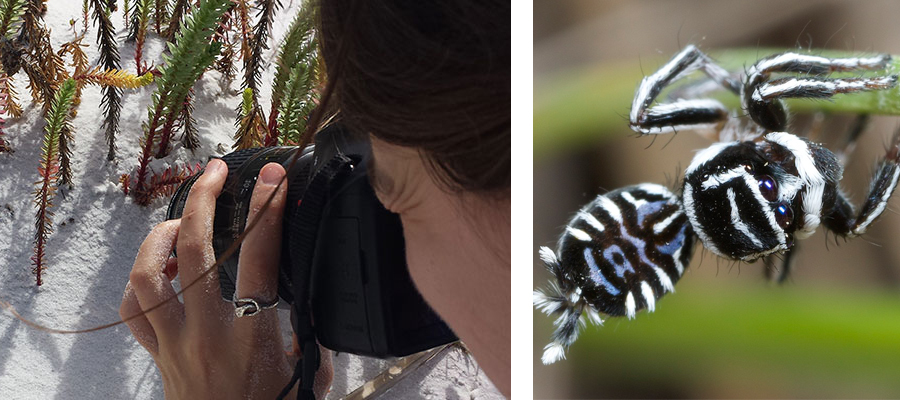 Left to right: "Sparklemuffin" during a mating dance, Girard in her lab, and a close-up of male (M. linnaei) peacock spider courting a female. Photos courtesy of Madeline Girard
Left to right: "Sparklemuffin" during a mating dance, Girard in her lab, and a close-up of male (M. linnaei) peacock spider courting a female. Photos courtesy of Madeline GirardESPM graduate student Madeline Girard had always loved animals, but it wasn’t until she took a course on animal behavior as an undergraduate student that she realized studying them could be a career. Through her research as part of the Rosenblum lab, she discovered two new species of peacock spiders, "Skeletorus" (Maratus sceletus) and "Sparklemuffin" (Maratus jactatus), and is working to build a phylogeny of the entire group. We recently caught up with Madeline to hear more about her research and the funky moves of the pretty spiders she studies.
What led you to studying spiders, and specifically jumping spiders?
Before coming to Berkeley for my graduate studies, I had field jobs working with honey bees, zebra finches, bowerbirds, and black widow spiders. The honeybee work got me interested in behavioral ecology, and the experience with bowerbirds (studying how males sing and dance to attract females) led me to a focus on animal mating and sexual selection. Peacock spiders are similar to these birds in many ways; they use dances in coordination with vibrational communication during mating rituals. Since I learned about these jumping spiders, I haven’t wanted to study anything else.
We don’t blame you! The videos and images of the spiders you study are incredible. Can you tell us a little more about what we are seeing?
Unlike many spiders, Australian peacock spiders have excellent visual systems. During courtship, the colorful male literally dances to get the attention of a female spider. He extends intricately ornamented abdominal flaps, waving them at the female in synchrony with his 3rd pair of legs. The abdominal flaps bear a striking resemblance to the fan of a peacock, which is a classic system in the study of sexual selection. The male also creates a lot of vibrations with his dance—it’s all pretty elaborate!
Do all the spiders do the same dance?
Each species has different physical characteristics and does a different dance. Very little research has been done on these spiders, so a lot of the work involves simply observing and describing characteristics and behaviors to establish a baseline knowledge and then comparing the differences between species. I’m mapping the characteristics of as many species as I can in order to build a phylogeny, which will help us better understand the evolution of this group of spiders. We have a lot of photos of how they look, but less record of the behavior of each type, so I spend lots of time recording spider mating dances in the lab.
And before all that, you have to have spiders to observe—what's your fieldwork like?
I usually spend a few months of the year with my colleagues in Australia, living out of a camper van and driving to remote areas to collect spiders to bring back to the lab. We definitely get strange looks from people who see us walking slowly, staring at the ground for a really long time!
 Madeline and her colleagues spend a few months of the year in Australia, observing spiders in their natural habitat and collecting them to take back to the lab for further study.
Madeline and her colleagues spend a few months of the year in Australia, observing spiders in their natural habitat and collecting them to take back to the lab for further study.You discovered two new species, “Sparklemuffin” and “Skeletorus,” while in Australia in 2013. How did you find them, and how did you come up with such fun names?
Searching for and catching spiders feels a little bit like a game; my colleague and I started joking that it felt like we were playing Pokémon! Our first brainstorms with these two new species were trying to play off of that. We didn’t come up with a good Pokémon reference, but "Skeletorus" came up because the spider is black with white lines resembling a skeleton (and we liked the subtle reference to Skeletor from Masters of the Universe!). Sparklemuffin just kind of popped up one day. We wanted something a little bit glamorous, which led to sparkle...and muffin works because the shape of the spider (which is more narrow at the interior of the abdomen and then puffs out at the top) sort of resembles a muffin top. It started as our nickname, but people really love the name and it has made the species really popular!
 Peacock spiders may be tiny, but there's quite a lot to see once you get up close. Right photo of "Skeletorus" by Jürgen Otto.
Peacock spiders may be tiny, but there's quite a lot to see once you get up close. Right photo of "Skeletorus" by Jürgen Otto.Do you think these two species have received more attention that others recently discovered?
For sure—I’ve been involved in the discovery of at least five new species, and some of the others in this group are also really beautiful. But these names have received a lot of attention. I care a lot about outreach and science education, so I’m glad these two have raised the profile of these spiders in general. A father recently wrote to me saying that his little girls had been afraid afraid of spiders but that after learning about "Sparklemuffin" they now think spiders are the coolest. I loved that!
